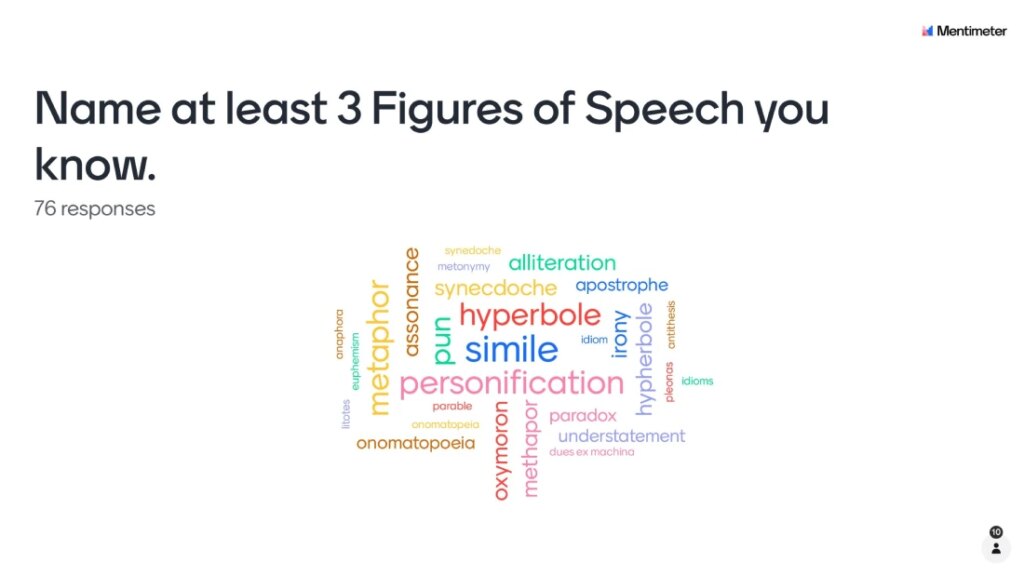

Introduction
If Science has a Table of Elements; English has a Table of Figures of Speech, too! Effective writing starts with understanding how to use words in sentences and play with their meanings. Thus, about language usage in its aesthetic purposes, the various types of Figures of Speech in English are your friends in adding colors your writings and even so in literary pieces. It can help you become more efficient in using the types creatively. For instance, crafting poems, writing novels, developing short stories, and other creative writing activities.
With the help of the types of Figures of Speech in English, you can enhance your creativity skills linguistically. In ancient English times, along with the succeeding ages of literature, writing different types of prose and poetry was one of the massive assets a man should have.
This work of art can make you express your emotions in subtle, satirical, romantic, and humorous ways, depending on your audience and choice of concept. Especially rhe type of Figures of Speech you are using to convey a message.

10 Common Types of Figures of Speech in English
Using a Mentimeter application as a survey tool for gathering data related to the Figures of Speech in English, the respondents come up with these words as they recall their learnings from their previous grade levels. They were asked to name at least three Figures of Speech in English they know and these words were the common answers according to the people who have responded to the survey.
In this survey for the Figures of Speech in English, Simile ranks as the most popular followed by hyperbole, personification, and metaphor. However, many Figures of Speech in English that are not visible in the picture above are not commonly used but may be useful in your creative writing.
1. Simile
This kind of Figures of Speech in English is used to compare things with the help of “like” and “as” in it. In which, it compares the similarity of one entity to the other. This helps to pair the symbolisms of humans with another thing in common.
Examples:
- You look like an angel in disguise.
- Jane is like a lion when mad.
- Stella is as bright as a star in our classroom.
- Her physique is as lovely as aurora borealis.
- Agatha is as fragile as the dandelions in the garden.
“Worrying is like a paying debt you don’t owe.”
-Mark Twain
2. Metaphor
It is used to compare two different things directly that are not true. It is also a way of giving meaning to an object with the help of comparing an idea or analogy to show such likeness between them. It does not use “like” and “as.”
Examples:
- She is a walking disaster.
- Anthony is a living dictionary in my school.
- Life is a journey, full of adventures and mysteries.
- Time is gold. Use it wisely!
- A pen is mightier than a sword.
“I watered it with fears,
night and morning with my tears.
I sunned it with smiles.”
-William Shakespeare
3. Hyperbole
It is a statement that is an exaggeration of a certain idea. This kind of Figures of Speech in English uses a lot of emotions such as anger, happiness, sadness, etc. which can be used to express something to an extent.
Examples:
- What a tiring day! I could sleep for a year.
- His anger could boil a cup of water.
- Anna cried in the river when her Mom died.
- Tiffany dropped Troy’s golden glass heart.
- John’s smile reached through his ears when he saw his crush.
“Her voice was a rich, vibrant contralto of intrinsic beauty.”
-Alan Blythe
4. Personification
It is used to give life to a non-living thing and inanimate objects. Writers and poets use this to put emotions and human qualities to things such as plants, toys, things in nature, etc.
Examples:
- The sunflowers are dancing in the garden.
- The sun is angry towards the humans.
- Three birds are singing in a choir in the sanctuary.
- The fog is hugging sweetly to the mountain.
- She took a photo under a crying sky.
“The fog comes on little cat feet.
It sits over harbor and city on silent haunches and then moves on.”
-Carl Sanburg
5. Oxymoron
This category of the Figures of Speech in English is composed of two opposite or contradictory words placed side-by-side together in a sentence to create another meaning. People used it intentionally for dramatic effect or to explain something in particular.
Examples:
- The town had a reality show last fiesta.
- I am clearly confused with his explanation.
- Josh ate the jumbo shrimp on the table.
- Due to globalization, we created a global village.
- Allan and Sam have similar differences together.
“Feather of lead, bright smoke, cold fire, sick health,
Still-waking sleep, that is not what it is!
This love feel I, that no feel love in this.”
-Romeo and Juliet; William Shakespeare.
6. Paradox
It is using two contrasting or opposite ideas in a sentence. Another interesting type of Figures of Speech in English which uses two contradictory statements to convey a message. It would sound silly but has a deeper meaning behind it. Moreover, this one is used to address an issue funnily, too.
Examples:
- I find strength in my weaknesses.
- I took the courage to get out of my fears.
- War is the only way to have peace.
- People helped him to go up just to look them down.
- Intelligent people talk less.
“Someday you will be old enough to start reading fairy tales again.”
-C.S. Lewis.
7. Irony
This is used to express that one’s intended meaning is the opposite of what one wants to convey. This category of Figures of Speech in English is also used for satires, criticisms, and subtle mockery of problems or gaps between what is said and its meaning. It could be sarcasm, secret, or clownery on something.
Examples:
- The mouse chases the cat.
- Teacher Dwight has a fear of public speaking.
- The police officer ran away when he saw the suspect.
- What a great day! I just lost my wallet.
- Oh! They are out of unlimited rice.
“A pair of star-crossed lovers take their life.”
-Romeo and Juliet; William Shakespeare
8. Onomatopoeia
Another type of Figures of Speech in English that uses a word to imitate the sound of an animal, object, nature, etc. These words help us to picture different things in our mind, even actions in various situations.
Examples:
- The splashes of the water create a relaxing sound.
- I can hear Jessica’s deep gulp after breaking the vase.
- Tick tock, Tick tock! What time is it?
- The duck quacks loudly in the river.
- Bamboo squeaking every night sounds creepy.
“Yet the ear, it fully knows,
By the twanging,
And the clanging,
How the danger ebbs and flows.”
-The Bells; Edgar Allan Poe
9. Alliteration
It is a kind of wordplay of a repetition of the first consonant sounds in the succeeding words. It is used to play with the sound to produce a rhyming scheme in words. Usually, tongue twisters are here to improve the phonemic awareness of an individual.
Example:
- Jack on Jumpers jumps with jars of jam.
- Willy whips a willow in the window.
- Railey reaches Rocky Road railway.
- The busy bumble bee buzzes on the bluebell bud.
- Gian guards the green garden.
“While I nodded, nearly napping, suddenly there came a tapping.”
-The Raven; Edgar Allan Poe
10. Pun
It is a funny use of words in a sentence used as jokes. They have words with similar sounds but have different meanings. This type of Figures of Speech in English is a clever way to say something about an issue in funny ways.
Examples:
- Why are Teddy Bears hungry? They are always stuffed! (Stuffed Toys)
- Let us taco about it. (talk)
- I am board I wish someone wood have fun. (bored; would)
- Are you a tower? ‘Coz Eiffel for you. (I fell)
- Do clay sheets get tired of being overused? (clichés)
“Now is the winter of discontent,
made glorious summer by this sun of York.”
-Richard III; William Shakespeare

10 Uncommon Types of Figures of Speech in English
Aside from the aforementioned common Figures of Speech in English, there are also rarely used ones that can be helpful in your writing. However, these are just a few from the long list of Figures of Speech in English. Here are the following:
1. Litotes
Litotes is a phrase that uses negation to create an affirmative understatement. For example, “That wasn’t half bad” uses negative phrasing to indicate that something was actually very good.
Examples:
- You are not ugly. (You are beautiful.)
- It is not a bad day. (It is a peasant day.)
- The government officials are not fooling around this year. (The government officials are serious this year.)
- Shane doesn’t have a few mistakes. (Shane has many mistakes.)
- Their platform is not uncommon. (Their platform is common.)
“Beowulf raised the hard weapon by the hilt,
angry and resolute — the sword wasn’t useless to the warrior.”
-Beowulf; Oldest English Epic
2. Antonomasia
It is used to substitute a person’s name. This type of Figures of Speech in English is also used to hide the identity of someone, which is referred to as an alias, penname, or one’s title.
Examples:
- The King of Pop made the music industry boom. (Michael Jackson)
- In England, the Bard of Avon made many literary pieces. (William Shakespeare)
- I just found my Mr. Right! (Boyfriend)
- The Iron Lady of Asia passed away after the National Election. (Miriam Defensor Santiago)
- The Star of Miss Saigon is going to Japan. (Lea Salonga)
“The fatal Cleopatra for which he lost the world and was content to lose it.” (Antony)
-Antony and Cleopatra; William Shakespeare
3. Euphemism
It is a literary device that indirectly addresses something or replaces a harsh word/s with mild ones. Especially when words are too embarrassing or unpleasant. This type of Figures of Speech in English is used to avoid taboo subjects, from uncomfortable to sensitive words.
Examples:
- Gio’s grandmother passed away. (died)
- Anthony’s dad is a Sanitation Engineer. (garbage man)
- Anne had a pregnancy termination! (abortion)
- Mentally challenged people need guidance. (retarded)
- Sue had a big bone but look at her now. (fat)
“I am one, sir, that comes to tell you your daughter and the Moor are now making the beast with two backs.” (having intimate intercourse)
-Othello; William Shakespeare
4. Synecdoche
It is a figurative language that uses a word to represent the whole; a part of something to whole and vice versa. It is used in a way that the reader may think something different from a certain part of a big thing such as a group of people, an object that has various parts, and so on.
Examples:
- Rey bought new wheels yesterday. (car)
- John asked Lucy’s hand in the middle of a concert. (asking to marry)
- I forgot to bring my Band-Aid with me. (bandages for wounds)
- Sean has 5 mouths to feed at home. (family members)
- I found a good head in our team. (intelligent person)
“I should have been a pair of ragged claws
Scuttling across the floors of silent seas.
-The Love Song of J. Alfred Prufrock; T.S. Eliot
5. Metonymy
A literary device used to associate something as a representation but not part of the whole. This type of Figures of Speech in English can create new imagery by thinking of a single thing representing a person or a concept.
Examples:
- I will adhere to the crown’s orders. (King)
- Pen is mightier than sword. (writing; war)
- The White House declared a global lockdown during the pandemic. (the President)
- I hear many tongues one at a time when I visit the city. (languages)
- Do you need any hand for that? (help)
“Half in appeal, but half as if to keep
The life from spilling”
-Out, Out; Robert Frost
6. Apostrophe
A type of Figures of Speech in English used to address someone who is not alive, not in the present, and cannot respond. It is also used to speak to a dead person, a thing, an issue, to the world, etc.
Examples:
- Oh! My beloved moon. Why are you so beautiful?
- I am sorry Mother Earth, I failed to protect you.
- My Persephone, I wish you were here.
- I will fight for you, My Philippines, until my last breath.
- How to make you calm, Sun? Your rage is burning.
“Thou wast not born for death, immortal Bird!
No hungry generations tread thee down;”
-Ode to a Nightingale, Jean Keats
7. Chiasmus
Another type of wordplay in the Figures of Speech in English that uses a reverse of a concept and words in order; to convey another meaning. It is used to create a rhythmic pattern in writing, that does not sound redundant.
Examples:
- A man for a woman and a woman for a man.
- One for all, all for one.
- He knows us and we know him, too.
- John gave knowledge to us and our ignorance has been taken.
- It takes love to sacrifice and it takes sacrifice to love.
“Let us never negotiate out of fear, but let us never fear to negotiate.”
-John F. Kennedy
8. Anadiplosis
A literary device that uses the last word of the sentence or line to be the beginning of the next sentence or line. This type of Figure of Speech in English is another wordplay to add rhythm and emphasis to the words used, like a string of related ideas in literary pieces.
Examples:
- The boat sinks; sinks slowly into the ocean; the ocean of nothingness.
- The government had corruption. Corruption that would lead to problems. Problems that would lead to poverty.
- The seen turned to bud. The bud turned into a flower. The flower wilted in despair.
- I file an application letter. An application letter for a job. A job that will make me a billionaire.
- The boy is writing a congratulatory letter; a congratulatory letter for his best friend.
“The general who became a slave. The slave who became a gladiator. The gladiator who defied an emperor.”
-Gladiator Movie
9. Anaphora
It is a repetition of the first words or phrase to the next sentence to emphasize the idea, concept, person, thing being referred to, etc. However, there are cases in which the words are similar, some may be synonyms or about the word or phrase.
Example:
- You are kind. You are talented. You are intelligent.
- Jane sings sweetly. She is a diva. Her voice deserves an award.
- I will fight for you. I will make you happy. I will be a better man.
- Joe sees nothing. Joe hears nothing, too. Joe is blind and deaf.
- The government is bad. It steals money. It kills innocent. It is such a shame!
“You may shoot me with your words,
You may cut me with your eyes,
You may kill me with your hatefulness,
But still, like air, I’ll rise”
-Still I Rise; Maya Angelou
10. Anthimeria
It is a literary device that converts a noun to a verb; a functional change in word rules. In this way, it exhibits how language is dynamic.
Examples:
- I will phone you later.
- I can keyboard this letter in just one minute.
- Will you please google this page?
- Chris turtled John’s assigned paperwork.
- The facts are not facting.
“The thunder would not peace at my bidding.”
-King Lear; William Shakespeare

Why Use Figures of Speech
There are many ways to make simple messages more lively and beautiful. Especially when we want to express something explicitly to someone; not to sound direct or literal but to be subtle and creative. Artistry is not just limited to visual and representational forms but also linguistics. The following are the benefits and importance of using Figures of Speech in English in our lives:
- Maximizes Creativity
Using figurative devices through Figures of Speech in English, you can enhance and develop more of your creative thinking skills. You can relate the context of your words to many things such as the environment, politics, nature, love, society, etc. Expanding your knowledge upholds the wit of how you can tame and weave some English words.
- Exhibits Therapy
The art of expressing your emotional tension through writing is a form of therapy to some which we call Catharsis. Instead of directly pointing them, verbally, you try to hide your intentions through your creative words. With the use of Figures of Speech in English, you can release your emotions. When you feel sad, write; when you feel angry, write; when you feel oppressed, write; and so on.
- Unleashes Dexterity
When you can apply Figures of Speech in English in your writing easily, you can unlock your mental dexterity, a skill in mind on how your hands coordinate with the way you creatively think, write, and express in a quick manner. Especially, in impromptu writing. You can easily connect your mind to your hands and produce many words quickly. With this skill, you reflect how well-versed and indulged you are with the English language.
Kindly click this PDF file link to see the comparison of how a simple sentence can be improved as they are too different when using figurative languages in English.
Key Takeaways
Using Figures of Speech in English enhances your fluency and mastery of the English language. It boosts your creativity skills, promotes therapy, and fines your dexterity skills. These are great components when it comes to creative writing. However, Figures of Speech in English are not always applicable in all situations.
Nonetheless, kindly be sensitive and mindful of the situation, environment, and nature of the message. In the office, reports, research, and other formal setting, for instance. Furthermore, learning is everywhere nowadays. With this, learning English at home can be a good way to enhance yourself, immersing in the language.



